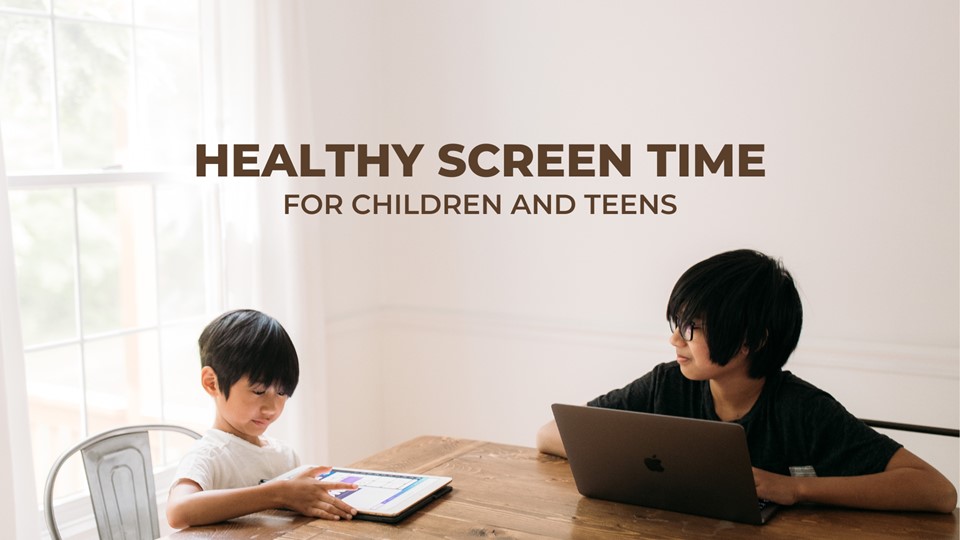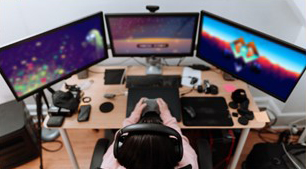Healthy Screen Time
 Healthy
Screen Time for Children and Teens
Healthy
Screen Time for Children and Teens
Watch a video presentation or download Powerpoint slides on the information that follows below.
Screens have become a part of our every day and are a main component of most technology – computer, mobile and smart devices, television - that we use to enhance or ease our lives. As we adapt and grow, we must teach children and adolescents how to have a healthy relationship with screens. Most adults alive today grew up with far less use of screens outside of family television time. Yet, they are raising children who are surrounded by screens from the moment they are born. These days, children see their parents on their phones from birth and it is common for parents to use screens as a distraction for busy children in situations where they may need some peace.
 Screen
Time Risks
Screen
Time Risks
Teachers can educate students and their parents about the risks of excessive screen use and recommendations for managing screen time. No child is too young for a screen time plan. Screens are best used as tools and not rewards.
- According to the American Academy of Child and Adolescent Psychiatry, “on average, children ages 8-12 in the United States spend 4-6 hours a day watching or using screens, and teens spend up to 9 hours. While screens can entertain, teach, and keep children occupied, too much use may lead to problems”. It is recommended that children spend much less time on screens per day than the current national averages.
- Discourage parents from using screens to stop tantrums or as pacifiers. If children begin to associate screens too closely with rewards and surges of dopamine in the body, it can lead to abnormal reliance on screens for emotional stability and regulation in the future, which can be the beginnings of addictive behavior. Screen use becomes an easy, fast coping skill for children and adolescents seeking to escape reality or avoid emotions that they are experiencing. They can find themselves detached from regular activities and daily life in preference of watching screens or playing games on devices.
- Other risks associated with too much screen time include increased risk of obesity, sleep deprivation, decreased cognitive ability, impaired socializing skills, weakened emotional skills, delayed learning, and lower self-esteem. Unsupervised screen time may increase exposure to risky behaviors, dangerous sites, and predators.
 Screen
Time Recommendations for Children
Screen
Time Recommendations for Children
- For children ages 2-5, non-educational screen time should be limited to about 1 hour per weekday and up to 3 hours on weekend days.
- For children six and older, non-academic screen time should be limited to 2 hours per weekday.
- Most importantly, screen time should be considered as family time as well, and not just time where your child is solitarily engaged. Screen time together will allow adults to have broader discussions about what a child is watching, and adults will be able to answer questions they may have about stories and themes in their content.
 Selecting
Appropriate Screen Media
Selecting
Appropriate Screen Media
Share reputable guidance resources such as Common Sense Media with parents to help them select and monitor appropriate screen media for their children and adolescents. Common Sense Media suggests that “with any screen media you choose for your kids (or they choose for themselves) -- movies, games, TV shows, apps -- you want to look for how it engages your child.”
- To allow, guide, and/or limit screen use, it is important to pay attention to the maturity level, ratings, and reviews of the media that the children are watching.
- Knowing your child’s particular interests, comfort levels, and questions they may have about what they are learning and watching is also important in the selection of media.
Common Sense also recommended that you consider the “four cs”: connection, critical thinking, creativity, and context in the selection of screen media.
- Connection - It is important that children have a personal connection with what they are playing and reading and watching.
- Critical Thinking - To engage critical thinking, look for apps and games that dive deep into a particular skill or subject and that allow children strategize through scenarios.
- Creativity - Media that allows children to create something new gives them more ownership over what they are learning so look for media that involves creativity.
- Context - Help your children discuss and consider what they are watching and learning about. Let them ask questions and ask them questions in return. You can extend the learning by doing related activities offline with your children as well.

